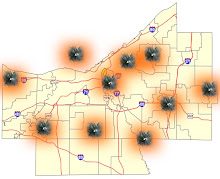Cleveland’s Public Square is an empty vessel. It no longer functions as the community space that Moses Cleaveland and the boys designed back in the early 19th Century. Sure, the square has hosted some important events, like Lincoln’s funeral procession, the filming of A Christmas Story, and some very Cleveland-like events, like the celebration that followed the Indians losing the 1997 World Series. And the Soldiers’ + Sailors’ monument is a very uniquely American structure, monument, and interpretive piece, unlike any other non-battlefield monument in the country. Yet in most part, Public Square has seen its better days.
Public Square and the Mall, the spatial progeny of the Burnham’s Group Plan, are flaccid relics of past urban design models. At one time each space constituted the democratic and green lungs of a thriving, dirty, and pulsing industrial city. No longer, though. Each space is devoid of relative meaning, use, function, or future. These organizing voids are merely vestiges of past planning strategies that no longer unite. We must either re-use these spaces intelligently, provocatively, or hand them over to private interests to be ruthlessly in-filled.
Let’s say we are forward thinking citizens, tired of the defeatism of the baby-boomer politicians of this one-party town who do not have to compete for votes with ideas. How should we approach the re-design or re-constitution of such deteriorating, yet historically important, and potentially instigating spaces?
Forget nostalgia. The 1950’s are gone, as well as Higbee’s, May Company, and the entire socio-economic climate that seeps from Dick Feagler’s black and white photographs.
Forget history. We do not need interpretive panels explaining what occurred in 1814 at this spot to alter Ohio history. We should keep the Soldiers’ + Sailors’ Monument, though--it is uniquely Cleveland and can anchor the whirlwind of urban change that can potentially occur. Everything else in the other quadrants can go. Small crowds gather for Downtown Memorial Day or Veteran’s Day ceremonies—many attend ceremonies in the suburbs.
Forget ceremony and tradition. The most tangible taste of ceremony that still inflects the square would be the Saint Patrick’s Day Parade. The Columbus Day parade has even left Downtown, scadaddling for the friendly confines of Little Italy.
Maintain the perimeter. Like many European public spaces which have been re-born again and again, the bounding periphery of the spaces have maintained their integrity while churning within over the centuries.
Re-think the circulation. Close down Superior, Ontario, or both, or recalibrate the flow of circulation through and around the square. How could parking be achieved in an alternative manner. How can RTA service or not service the area?
Engage technology. Wi-fi clouds, Ipods, nanotechnologies, smart advertising technologies, infinite accessibility and connectivity are evolving the constitution of our shared public spaces. Could a public space be automatically personalized by your presence?
Provide Protest Space. Where could a good protest occur? The closest event that resembled a protest was John Kerry’s election concert on the Mall. Pro-Choice and Pro-Life counter demonstrations would surely charge-up and enliven the commons.
Embed Flexibility. As society evolves at an ever-quickening pace with technological innovation, Public Square needs to be able to change as quickly. Accepting temporality and an ephemeral character may compose the proper concoction to assure lasting reliance and relevance.
Encourage Ad-hocism.
And we could continue on.
But first and foremost, we cannot let the saccharin, one-off, life-style center skin-deep post-modernism + weak contextualism of the Plain Dealer scheme define and lead-off our collective regional future. We are better than the vision of the presented Plain Dealer scheme--if we do not recognize and reject this utter shallowness, we are not worthy to call ourselves competent architects + urban designers.
Subscribe to:
Post Comments (Atom)





1 comment:
The public square, so often the site of defining civic struggles, is in many ways a city’s heart. This short magazine article profile's public squares from around the world to reveal their chequered histories.
http://www.walrusmagazine.com/articles/2008.02-architecture-public-squares/
Post a Comment